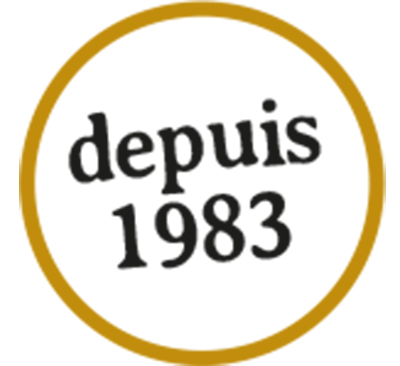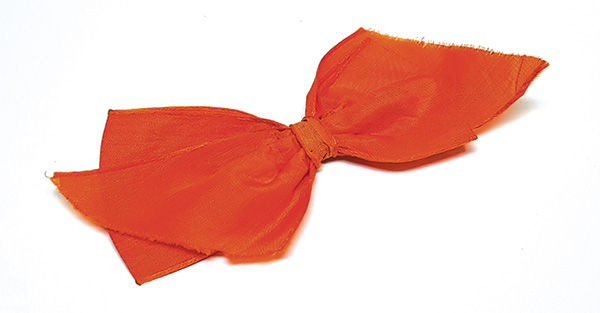Freedom wrapped up in a bow

Un texte de Heather Darch
Paru dans le numéro Automne/Fall 2021
Publié le : 24 août 2021
Dernière mise à jour : 2 septembre 2021
The Dutch government still sends thousands of tulips to Ottawa as an ongoing thank you for the liberation and for providing sanctuary to the Dutch royal family who lived in Canada in exile. The little orange bow in the Missisquoi Museum’s collection represents the fact that freedom had, and still has, a price.
Before a small orange-coloured silk bow came into the collection of the Missisquoi Museum, it was kept under glass by its owner who cherished it as a gift from a beloved uncle, but who also recognized its significance in terms of Canadian history. Ernest Gordon Wilkins (1907-1991) born in Abercorn, Quebec and who served in the Canadian Infantry Division in WWII, gave the hair bow to his niece as a keepsake when he returned from his military service following the liberation of the Netherlands.
For five years during WWII, the German army brutalized and starved the people of the Netherlands. The Nazis sent almost three-quarters of the Netherlands’ Jewish population to concentration camps like Vught and Mauthausen-Gusen, Bergen-Belsen and Auschwitz-Birkenau ; approximately 500,000 Dutchmen were transported to Germany where they worked as slave labour in factories; they looted and destroyed homes and businesses; displaced hundreds of thousands of people from their communities and executed thousands of resistance fighters until the dying days of the war. In retaliation for a two-day general strike that was staged to disrupt the German war effort, Germany stopped food shipments to the western Netherlands, creating the “Hunger Winter” of 1944-1945. Cut off from already depleted provisions, millions of Dutch civilians faced starvation and resorted to eating tulip bulbs just to survive.
From September to November 1944, the First Canadian Army fought German forces on the Scheldt Estuary. Their victory at the Battle of the Scheldt allowed the liberation of the southern parts of the Netherlands and gave Allied ships access to the vital port of Antwerp, Belgium and allowed them to close in on the Reich from all sides.
The Christmas of 1944 saw the first signs of freedom for the Dutch, but it took until the spring for this to be realized throughout the country. Canadian Infantry Divisions were successful in providing both food and medical relief to reach desperate civilians even while the war raged around them. After holding out over the winter, reinforcements arrived in the Netherlands to support their fellow Canadians. When the new Allied offensives began in 1945, the First Canadian Army helped liberate the northeastern and western Netherlands, until the German resistance finally collapsed and the German Army officially surrendered in early May.
On April 16, 1945, during the final month of the war, Theo Polman recorded in his diary that the 2nd Canadian Infantry Division liberated the city of Groningen. The combat was significant for both the participants, as well as the citizens, who lived through four days of fierce street fighting until victory was finally achieved. He recorded that his family huddled in their home through the battle and noted their interactions with Canadian soldiers after the fighting stopped. One small detail proves poignant: After their midday meal Bep placed an orange bow in Nelly’s hair and a sash around the waists of both her children: “We have waited 5 long years for this moment and now it really is here!” (16 April, 1945). Many accounts from veterans express the profound happiness of the Dutch people with the liberation of their country from German occupation: And everybody had something orange on, for the House of Orange. You know, arm bands and little girls had hair ribbons and they sang their beautiful national anthem, they had their own flags. It was wonderful.
If one looks closely at the numerous images of Dutch people following the liberation, bows and ribbons can indeed be seen in girls’ hair and while the images are in black and white, we can imagine the colour orange helped to set a joyous mood in what came to be known as the “Sweetest Spring.”
More than 7,600 Canadian soldiers, sailors and airmen died in the nine dreadful months it took to liberate the Netherlands ; a tremendous sacrifice for the cause of freedom. They are buried in cemeteries from Adegem, Belgium, to Rheinberg, Germany. The largest, Groesbeek Canadian War Cemetery near the city of Nijmegen, holds the graves of more than 2,300 Canadians. Over 75 years later, the Dutch remember. The liberation of the Netherlands is studied by school children and it is commemorated annually by communities across the country. And the Dutch government still sends thousands of tulips to Ottawa as an ongoing thank you for the liberation and for providing sanctuary to the Dutch royal family who lived in Canada in exile. The little orange bow in the Missisquoi Museum’s collection represents the fact that freedom had, and still has, a price.
Heather Darch

